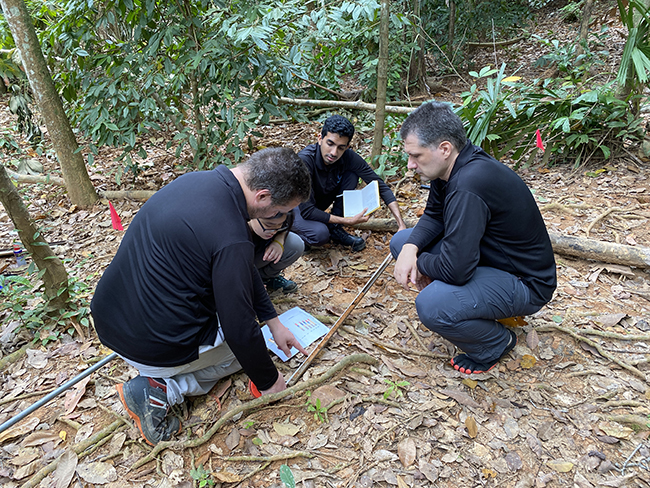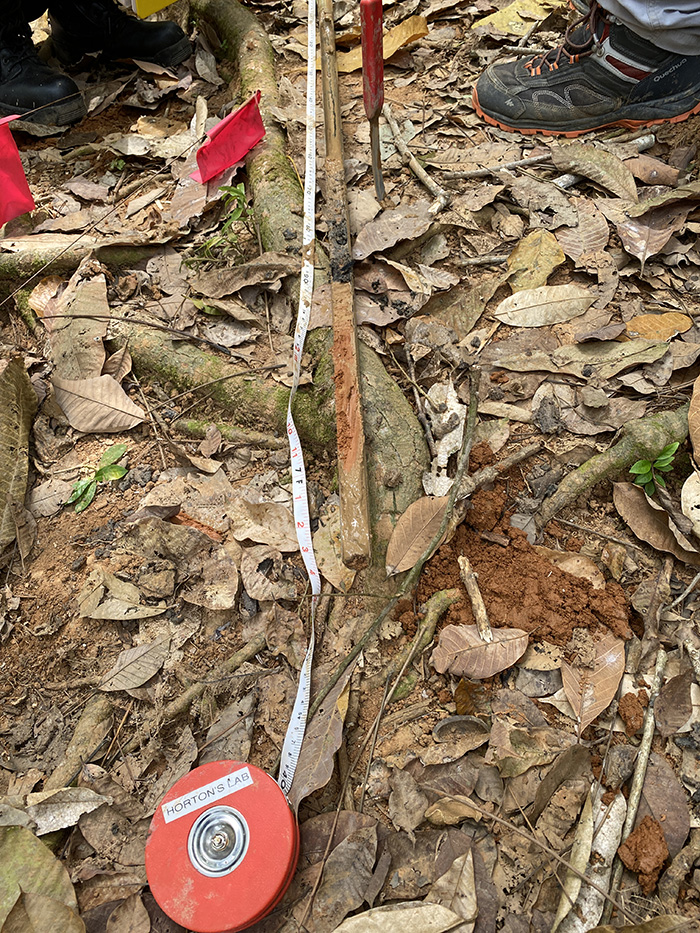In this interview series, we learn about the perspectives of the PhD students whose wide-ranging work contribute to the SEA2 Program and share what drives them in their research.

The past sea levels of the Holocene period can be reconstructed via the use of paleo-proxies, including the use of mangrove sediments, which contain organic materials that can be carbon-dated and serve as age markers and one person working on such historical records is Christabel Tan, a second-year PhD student on Professor Benjamin Horton’s research team.
 Collecting sediment core data for her thesis at Pulau Ubin, she studies and analyses their contents to help fine-tune sea-level models that would predict future sea-level rise.
Collecting sediment core data for her thesis at Pulau Ubin, she studies and analyses their contents to help fine-tune sea-level models that would predict future sea-level rise.
“The main thing we are trying to do is assess the utilisation of mangrove sediments to reconstruct sea level using Singapore as a case study,” she explains.
“Mangroves lie in the intertidal environments, so they can give an indication of tide levels, which we are trying to establish in the project. This relationship, we assume, is the same during the Holocene as we think there weren’t climate changes during this period.”
Macrofossils, such as mangrove pollen, plant materials, and foraminifera shells found in these sediments can be carbon-dated to indicate the age of each type of sediments at different depths, reflecting the tidal conditions at that particular time period. From this, we can deduce the different sea levels that have occurred over time.
“If surface mangrove pollen is related to the vegetation we see right above it, then we could use this information to see, when we analyse it, what kind of mangrove pollen we have found and whether it matches with any surface mangrove pollen composition,” Christabel elaborated. “This can tell us if it was a more inland or seaward mangrove.”
The type of pollen found at each depth is also a clue to the kind of environment the surrounding area might have been at a particular time in the past.
“In the pollen trap, we might collect only wind-borne pollen and it might be representative of what we might find in the canopy. But in the sediment stage, we might also have pollen that is brought in by water sources and it might not be directly representative of the vegetation above it in the past,” she explained.
“If what we find in the pollen trap is the same as what we see in the sediment, then we could say that this pollen is representative of the vegetation in that area and use this knowledge to relate to what we find in the sediment cores.”

Her interest in looking at sediment cores for answers started when she was an Environmental Studies undergraduate specialising in geography at the National University of Singapore. Using ostracods, which are sensitive to environmental changes and can be used as a pollution indicator, to support instrumental measurements, she was working on a Final Year Project that would eventually extend into examining sediment cores for similar species compositions as well.
“I was working in the geography lab, where I analysed all the surface samples for ostracod species and composition,” she recalled.
“But as my professor collected sediment cores as well, he also wanted to find the relationship between ostracods and pollution at the surface to see if you could find a similar species composition in the core, as it could shed light on past environments as well.”
Today, her experience in ecology bolsters her current research interests with sea-level history.
“Besides working on the index points, I’m also trying to reduce the uncertainty of sea-level index points that mangroves have,” she added, “because one of the key issues with mangrove sediments is that mangrove roots penetrate very deep down and they would disrupt the chronology of these sediments.
When you date them, for example, they might be at an age younger than the ones above it because the sediments were bioturbated. So that’s another aspect that I’m trying to address in my project – to try quantifying them and then producing more reliable radiocarbon data.”
Sea-level index points refer to the specific positions of relative sea levels in the past.

Further to that, she is also curious to see if there is a way to establish a rough visual estimate of age with plant materials, one of the macrofossils used for determining sediment age in cores.
“What we plan to do is pick fresh ones and degrade them in the ground, and maybe try to find a way to accelerate the degradation so that we can see how it looks like. Then we’ll compare it to what we find in the sediment cores, which are very old. I think that would be an interesting project – finding out how to accelerate the degradation of plant materials.”
As with any plan, however, there will sometimes be unexpected bumps along the road – such as getting her equipment stolen by monkeys at the rustic island of Pulau Ubin.
“We had to monkey-proof our pollen traps,” she recounted. “I was trying to search online to see if anyone has had their fieldwork equipment stolen by monkeys before, but there hasn’t been.”
What excites her most about her work, though?

“I think it’s the coring work I’ve done in Ubin, because that is the key in (obtaining) the sea-level index points, to get the mangrove sediments from beneath the ground, which is the basis for all my work.
We’ve managed to find this mangrove sediment layer above the marine clay which was also of the Holocene age, so it could fill in some gaps in the sea-level history of Singapore. With this data I produce, the sea-level index points can also improve glacial isostatic adjustment models that we use to understand sea-level changes across time and future sea-level predictions.
I think obtaining sediment cores have been really exciting and important, and I’ve gotten to listen to stories shared by the senior researchers too. Such trips have helped me learn a lot more than just sitting in the office and reading papers – it can’t compare to what I’ve experienced in the field and the great company I have.”
And if there was a song that could represent her PhD journey so far?
“Stand by Me,” she replies. “Without the leadership, guidance, and support from the sea level research team, I would not have made it so far.”